Physical Address
304 North Cardinal St.
Dorchester Center, MA 02124
Blind intubation techniques have proven to be effective, safe, and simple techniques, especially in a timely manner during emergency situations where fogging, presence of blood, secretions, and vomitus can create impossible conditions for the direct or indirect laryngoscopic visualization of the glottis or when alternative options are either unavailable or not functional. Successful nonvisual intubation depends largely on the clinician’s preparation, experience, and skill.
Blind digital intubation may be considered in situations where positioning for conventional intubation is not possible.
Pulling of the tongue forward by an assistant during the digital technique facilitates traction on the epiglottis, thereby improving the overall chances of successful digital intubation.
Blind digital intubation may be facilitated by the use of a tracheal introducer, which produces confirmatory tracheal clicks prior to the railroading of the endotracheal tube (ETT) and can facilitate intubation using various devices and techniques.
The use of a stethoscope, BAAM, Endotrol ETT, lighted stylet, and cuff inflation are all helpful adjuncts and maneuvers to improve the success rate of blind nasal intubation.
If not contraindicated, neck flexion (if ETT is caught anteriorly on epiglottis) or extension (if ETT keeps entering the esophagus) can help the clinician successfully intubate a patient during blind nasal intubation.
Retrograde intubation may be considered in a “CANNOT intubate, CAN oxygenate” (CICO) scenario.
The technique of the placement of an endotracheal tube (ETT) in the trachea for ventilation and oxygenation is more than a thousand years old. It was first performed on pigs by the Arab Avicenna between 980 and 1037. , However, modern methods of laryngoscopic tracheal intubation did not emerge until early in the 20th century following the introduction of a flexible metal tube by Kuhn and the laryngoscope by Jackson. Over the years, direct laryngoscopic intubation has been shown to be an effective, safe, and relatively easy technique. Using a laryngoscope to obtain line of sight to the laryngeal inlet has become the conventional method of tracheal intubation in the operating room, intensive care unit, and emergency department. Unfortunately, even in the hands of experienced laryngoscopists, this approach to intubation has limitations, especially in the presence of specific anatomic variations, such as a receding mandible, prominent upper incisors, restricted mouth opening, or limited movement of the cervical spine. The incidence of difficult and failed intubation employing this technique can be as high as 21%, particularly in emergency situations. In the obstetrical population the incidence of failed direct laryngoscopic intubation has been reported to be between 0.05% and 0.35%. Many predictors of difficult direct laryngoscopic intubation have been suggested in the literature over the past few decades. , Unfortunately, almost all univariate predictors have low positive predictive value and the use of multivariate predictors appears to improve the positive predictive value of these airway assessment tools for direct laryngoscopy. Moreover, studies have shown that considerable experience is required before a trainee becomes proficient in direct laryngoscopic intubation. Konrad et al. and Mulcaster et al. have constructed learning curves demonstrating that a 90% probability of success requires between 47 and 57 direct laryngoscopic intubations in patients. ,
These difficulties and failures associated with direct laryngoscopic intubation have driven the development of many alternative intubation devices and techniques, such as rigid and flexible endoscopes, video laryngoscopes, and optical intubating stylets. All these devices have gained a measure of popularity. Unfortunately, these devices are substantially more expensive than the laryngoscope. Furthermore, the cleaning and sterilization processes of some of these devices, such as the flexible intubation scope (FIS), require an average of 50 to 60 minutes to complete, hindering their availability and practicality in emergency airway management and in prehospital care.
Given that direct and indirect laryngoscopic visualization of the glottis may not be possible, especially in a timely manner during emergency situations where fogging, presence of blood, secretions, and vomitus are frequent, several devices and techniques have been developed to enable the clinician to pass the ETT “blindly” or “nonvisually” into the trachea. It is precisely these kinds of difficulties that have motivated the search for nonvisual techniques, such as digital intubation, blind nasal intubation, and retrograde intubation, all of which have proven to be simple, effective, and safe techniques.
These nonvisual techniques are particularly useful in low- and middle-income countries with limited resources. Our experience in Rwanda as part of the Global Outreach Program funded by the Canadian Anesthesiologists’ Society confirmed the clinical utility of these nonvisual techniques. The availability of contemporary airway management devices in Rwanda proved difficult because either they were cost prohibitive or there was no service for the devices should they become nonfunctional. Therefore in the setting of countries with limited resources inexpensive nonvisual techniques may play an important role when faced with a failed tracheal intubation under direct laryngoscopy. While some may find nonvisual techniques obsolete, we believe that the basic principle of airway management is to provide adequate oxygenation and ventilation to patients and this should depend on the context as well as the tools available to clinicians in their particular environment.
Although likely first described by Herholt and Rafn in 1796 for drowning victims, digital intubation did not receive much attention in the medical literature until its revival in emergency medicine and prehospital care by Stewart in the mid-1980s. , Notable publications on the topic over the years have portrayed the technique as an acceptable alternative to conventional direct laryngoscopic intubation, particularly when the conventional technique is contraindicated, has failed, or is not possible because of a lack of equipment. In 1880 Macewen described the technique of utilizing a curved metal tube in awake patients, and Sykes recommended the routine use of the digital technique in anesthetic practice in the 1930s. Siddall and Lanham considered the technique to be a last-ditch effort following failure of conventional intubation methods. The technique has been described in neonatal resuscitation and as an adjunct in blind nasotracheal intubation. Currently, there is widespread variation in awareness, expertise, and application of the technique in anesthesia, emergency medicine, , and prehospital care. Unfortunately, digital intubation is now often forgotten when the time comes to think about alternate techniques in the case of an emergency, despite a recent cadaver study establishing that the overall success after three attempts may be as high as 90%, when performed by emergency medicine residents and staff. Although advances in airway management equipment and expertise have made the routine use of digital intubation obsolete, it remains a valuable skill for some patients, especially in the emergency setting or under circumstances with limited resources and in which the clinician cannot be positioned at the head of the patient, rendering direct laryngoscopic intubation impossible.
The use of the digital technique is neither aesthetically pleasing and easily accomplished nor entirely safe. Placing the fingers far enough down a patient’s throat to elevate the epiglottis and guide an ETT into the trachea has implications related to the selection of patients and the manual dexterity and anatomic features of the clinician. The technique has received some popularity in the prehospital care environment, where difficult positioning of the patient, poor lighting conditions, disrupted anatomy, potential cervical spine instability, and unknown infectious status are the norm.
Successful digital intubation demands that the patient be unconscious to tolerate the intense oropharyngeal stimulus without triggering a gag reflex and to prevent bite injuries to the clinician. The risk of infectious disease transmission must always be borne in mind. Neuromuscular blockade facilitates the technique, although its use should be considered carefully in patients with anatomically difficult or disrupted airways. The skill level of the clinician, coupled with previous experience in using the technique of digital intubation, is an important prerequisite for success. The importance of practicing this technique in nonemergency situations cannot be overemphasized.
Digital intubation may be indicated as follows:
When equipment for tracheal intubation is unavailable or not functional.
When the positioning of the patient or the clinician prevents traditional laryngoscopic intubation.
When other methods have failed or are likely to fail and the skill and experience of the clinician make the digital technique a reasonable alternative.
When there is a potential or actual cervical spine instability and the clinician selects the digital technique based on the risk–benefit analysis. Although there is no evidence to suggest that the technique of digital intubation will alter the neurologic outcome of a patient, there may be less cervical spine motion during intubation with the digital technique as compared with the conventional direct laryngoscopic intubation without in-line immobilization.
When adequate visualization of the airway to allow conventional intubation is not possible because of the presence of copious secretions, blood, or vomitus in the oropharynx or because of traumatic injury of the upper airway anatomy.
As with any intubation technique, preparation involves assembling the necessary personnel and equipment, including emergency drugs, rescue airway devices, an oxygen source, and adequate suction, to optimize success and preserve ventilation and oxygenation. An appropriately sized ETT is selected. The use of a stiff but malleable stylet improves maneuverability and facilitates glottis passage of the ETT during the intubation. What follows is a classic description of the technique. The lubrication of the stylet with a water-soluble lubricant ensures easy retraction following the placement of the tip of the ETT in the glottis opening. The stylet is inserted into the ETT so that the distal end of the stylet is at the level of the Murphy eye. With the stylet in place, the distal half of the styletted ETT unit is bent to a “U” shape ( Fig. 21.1 ). The proximal half of the styletted ETT is then bent 90 degrees to the dominant side of the clinician to allow the manipulation of the styletted ETT by the dominant hand during intubation ( Figs. 21.2 and 21.3 ). The degree of bend at the tip of the styletted ETT should be individualized and is dependent on the clinician’s experience.
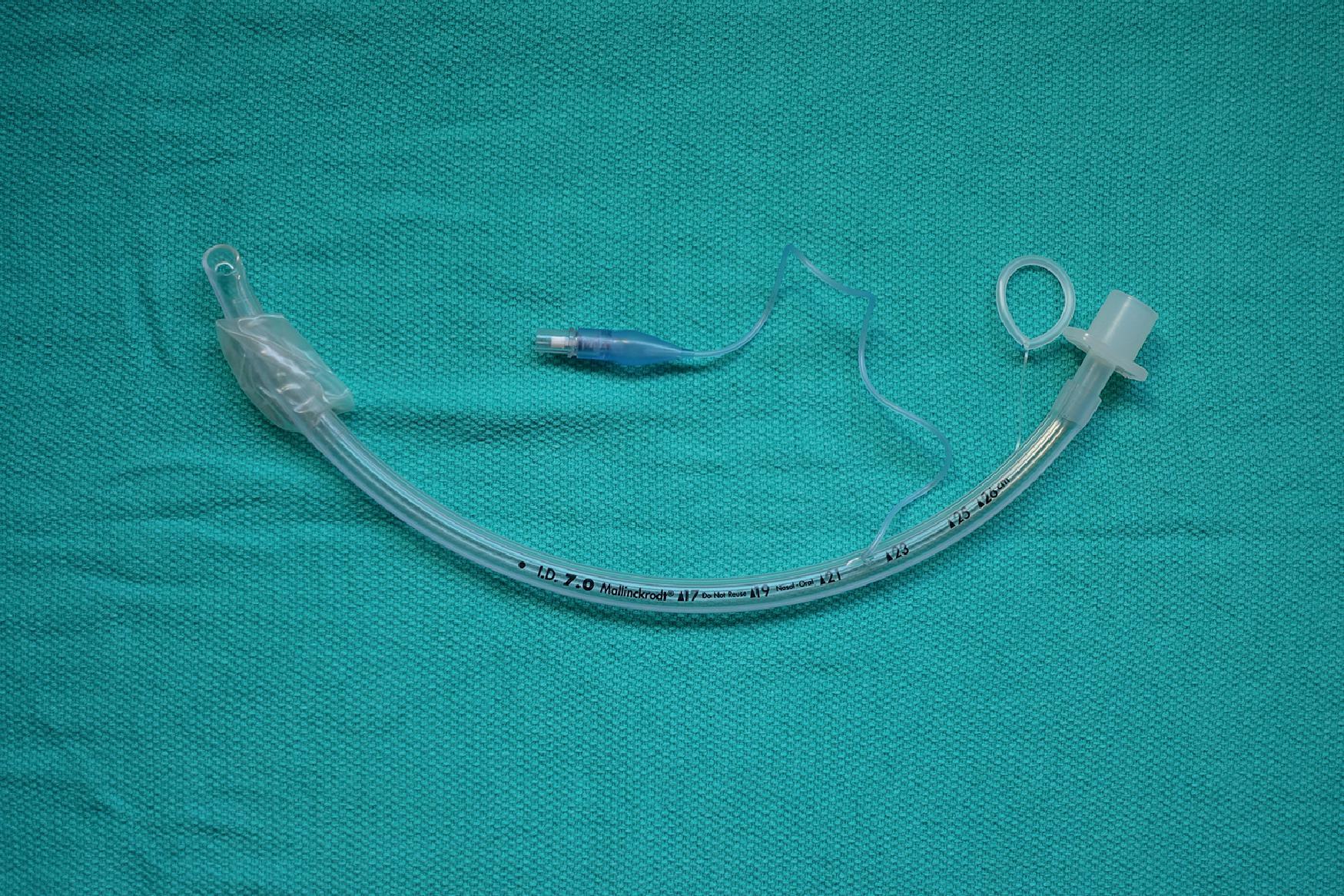
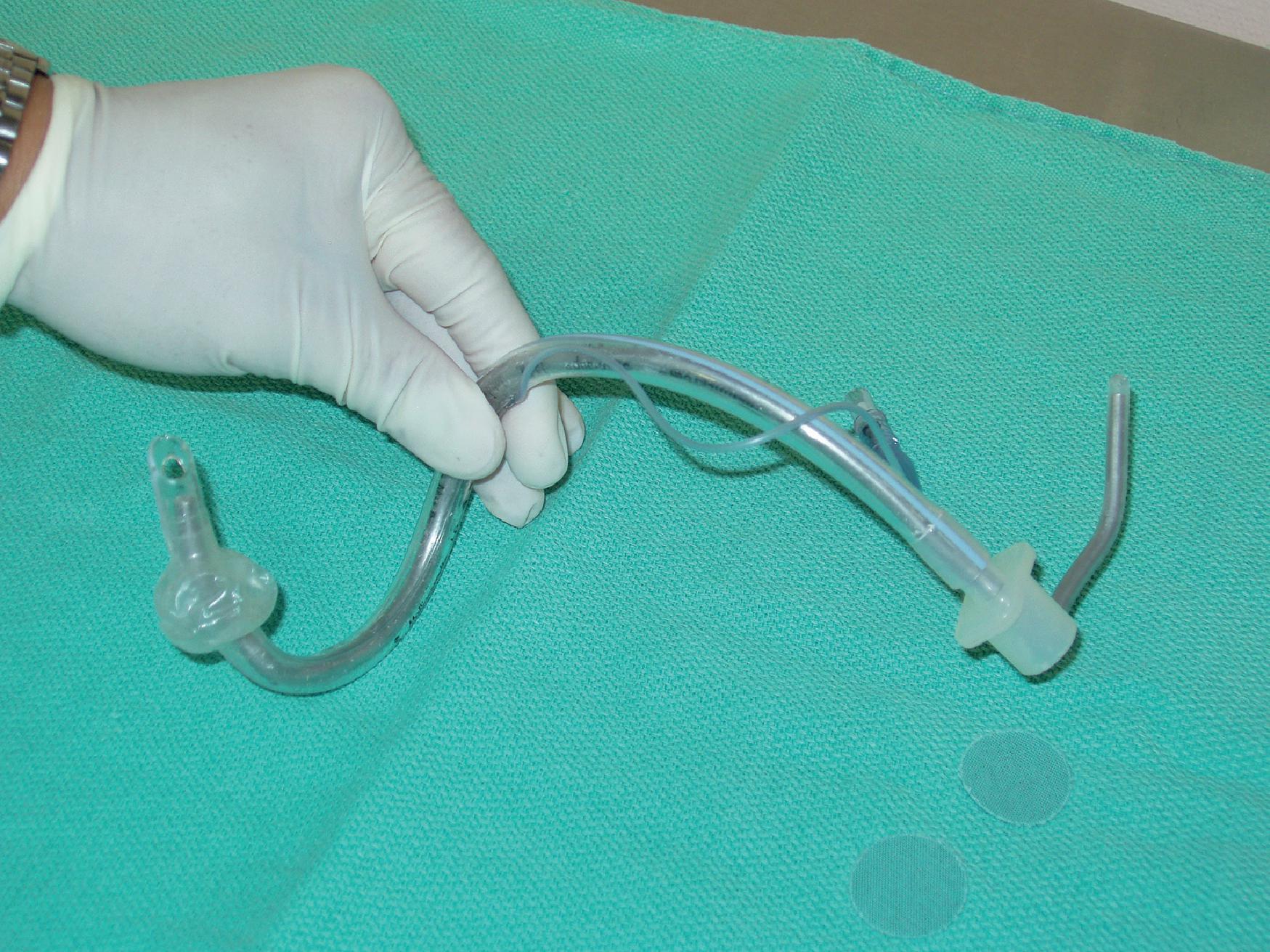
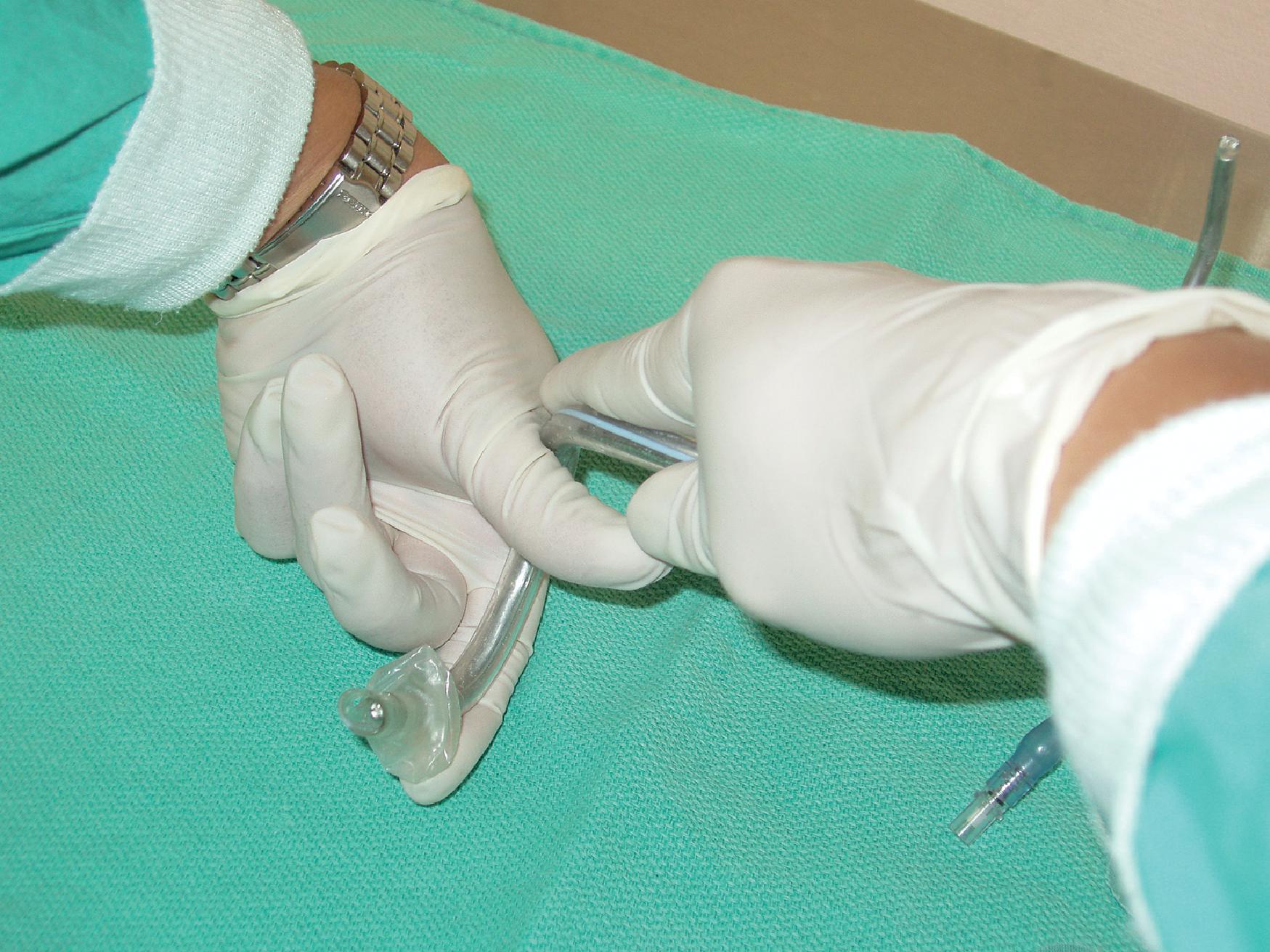
The tip of the ETT should also be well lubricated with a water-soluble lubricant. In the uncommon event that the intubation is performed in an awake patient, especially an uncooperative patient, a wedged bite block should be placed between the patient’s molars on the opposite side to where the clinician stands to minimize the risk of injury to the clinician’s fingers.
Depending on the environment, in general, the patient should be placed supine with the head in a slight sniffing position (except in patients with cervical spine instability). The clinician stands (or kneels if the patient is on the ground) beside the patient and faces the head so that the nondominant side of the clinician is closest to the patient. An assistant can help to facilitate the intubating procedure. In-line immobilization should be performed in the setting of cervical spine instability. Cricoid pressure should be applied where clinically indicated.
Digital intubation is a technique that may be considered in the prehospital setting for an unresponsive patient who is trapped in the seat of a crashed motor vehicle. This is an environment where the patient is likely to be in a sitting position, making traditional laryngoscopy challenging. The airway is likely to be bloody, which can impair glottic visualization with video laryngoscopy, and more advanced airway equipment may not be available. Digital intubation is a simple technique that allows the clinician to manage the airway while facing the patient or standing at the opening of the driver’s door. The location of the driver’s seat may influence which hand the clinician uses to palpate the epiglottis versus that used to deliver the ETT. The driver sits on the left side of the car in North America, making it easier for the clinician to place the fingers of the left hand into the oropharynx and deliver the ETT with the right hand. This approach would be ergonomically awkward in countries where drivers are seated on the right side of the car, and reversing the roles of the hands should be considered ( Figs. 21.4 and 21.5 )
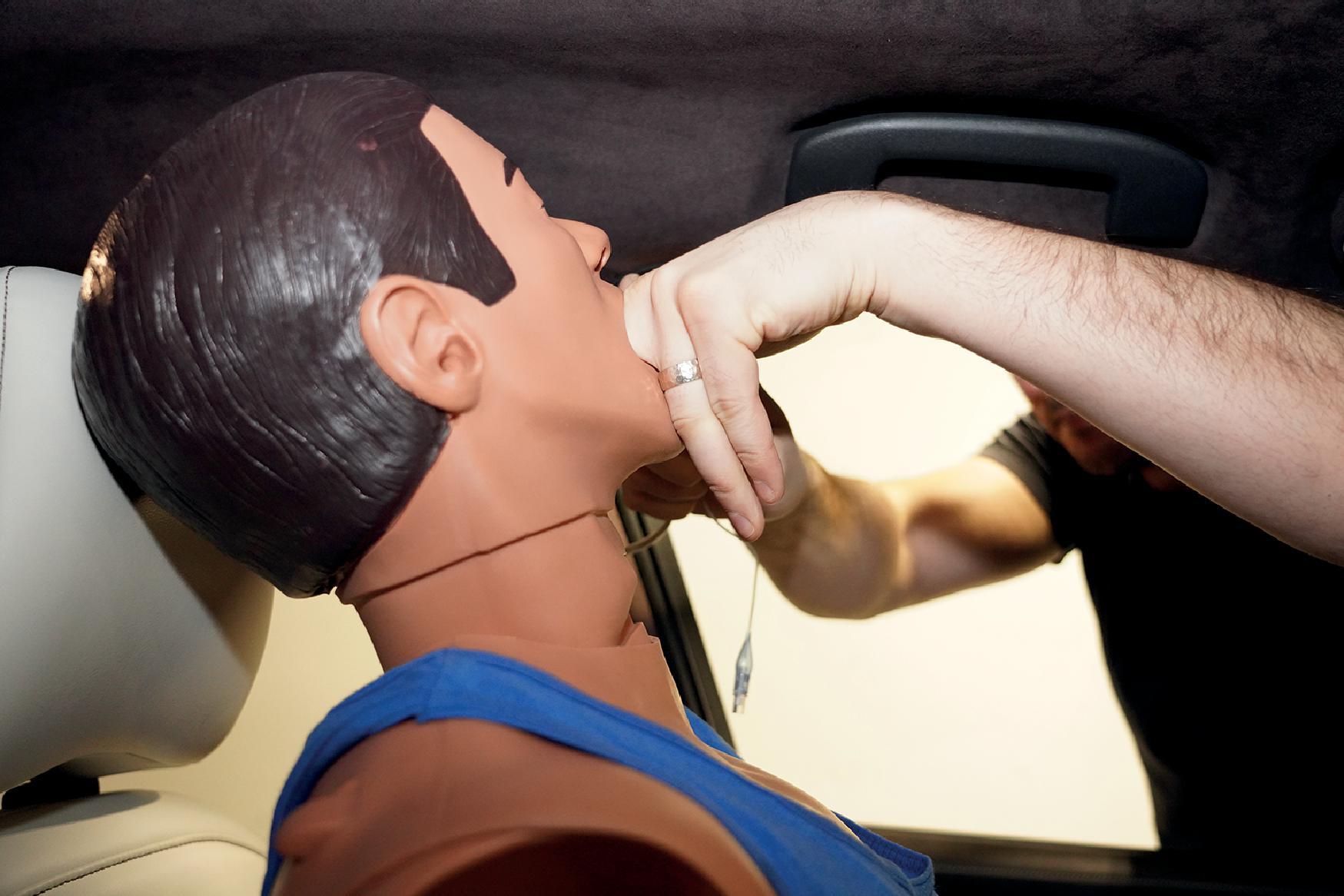
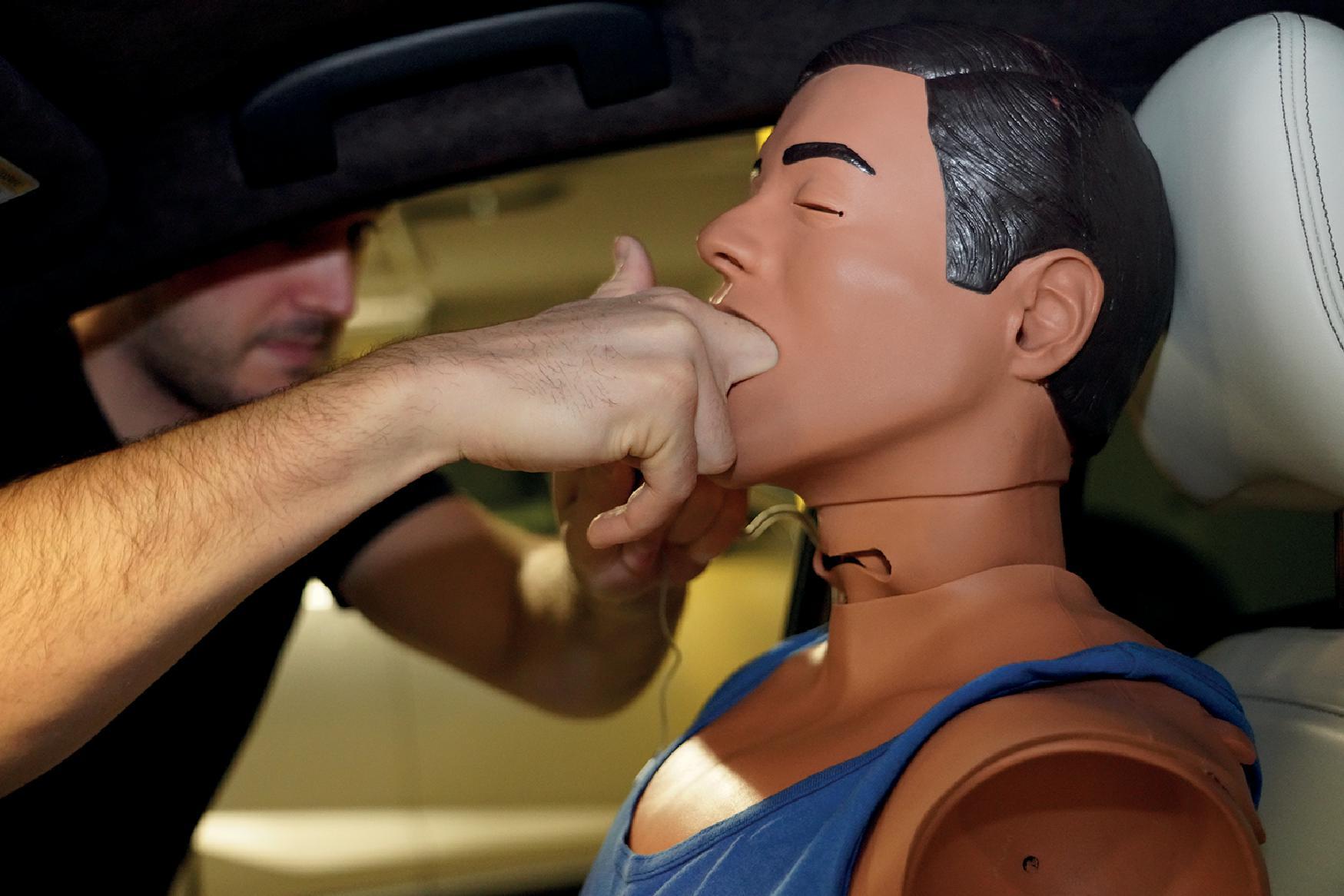
Pulling the tongue forward by an assistant facilitates the palpation of the epiglottis, thus improving the success rate for digital intubation. This can be achieved by applying suction tubing to the tip of a 20-mL syringe with the plunger removed ( Fig. 21.6 ). The tongue will be sucked into the open end of the barrow of the syringe, allowing it to be grasped gently by an assistant with a piece of gauze. Traction on the tongue moves the epiglottis slightly cephalad, enhancing its palpability and facilitating the placement of the tip of the ETT into the glottic opening. The clinician then inserts the index and middle fingers of the nondominant hand into the oral cavity and slides the palm down along the surface of the tongue ( Figs. 21.7 and 21.8 ). The tip of the middle finger touches the tip of the epiglottis, which is then directed anteriorly ( Fig. 21.8 ). The ease of palpating and lifting the epiglottis depends on the length of the clinician’s fingers, the height of the patient, the anatomy of the oropharynx, and the presence or absence of teeth.
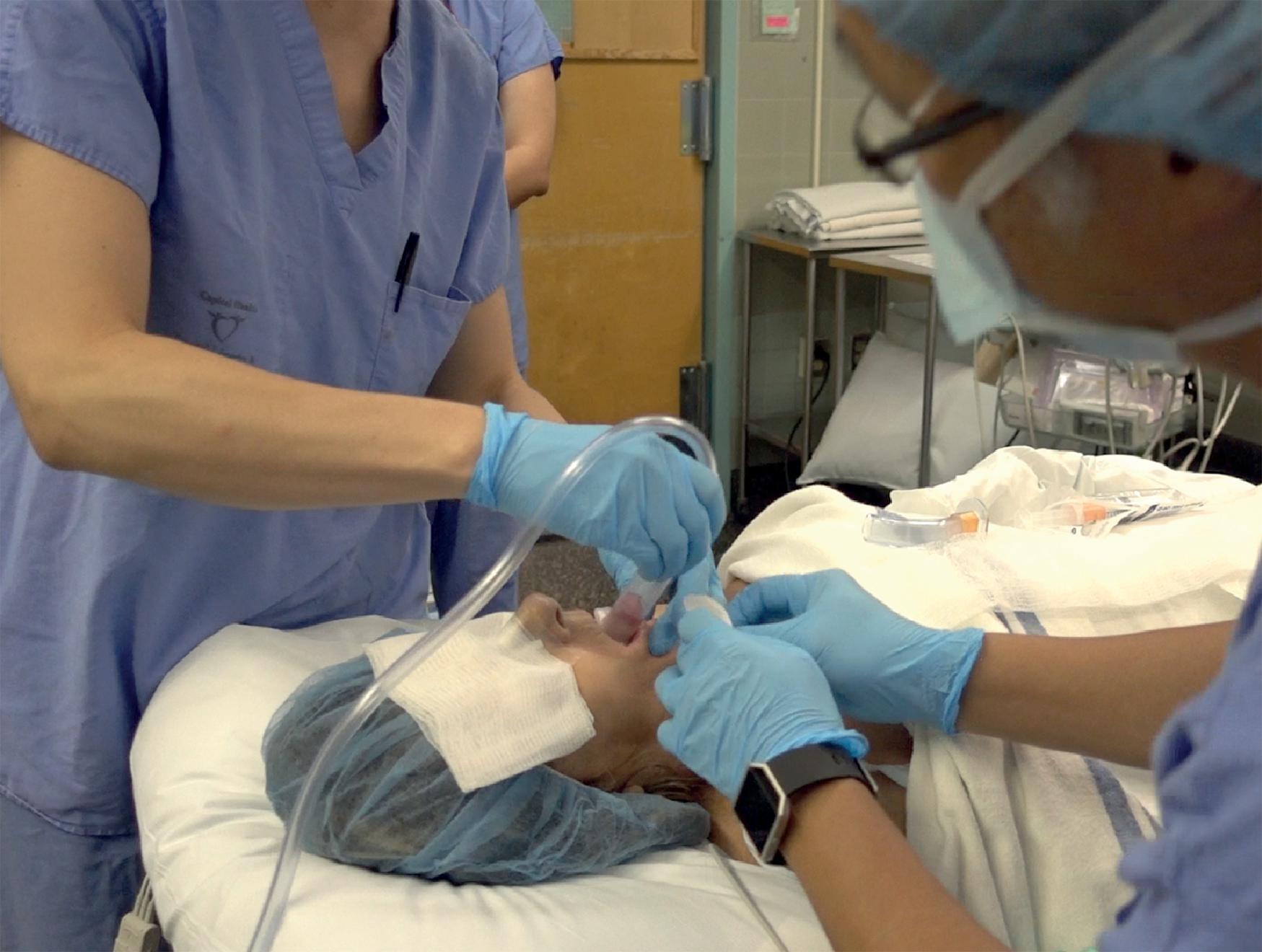
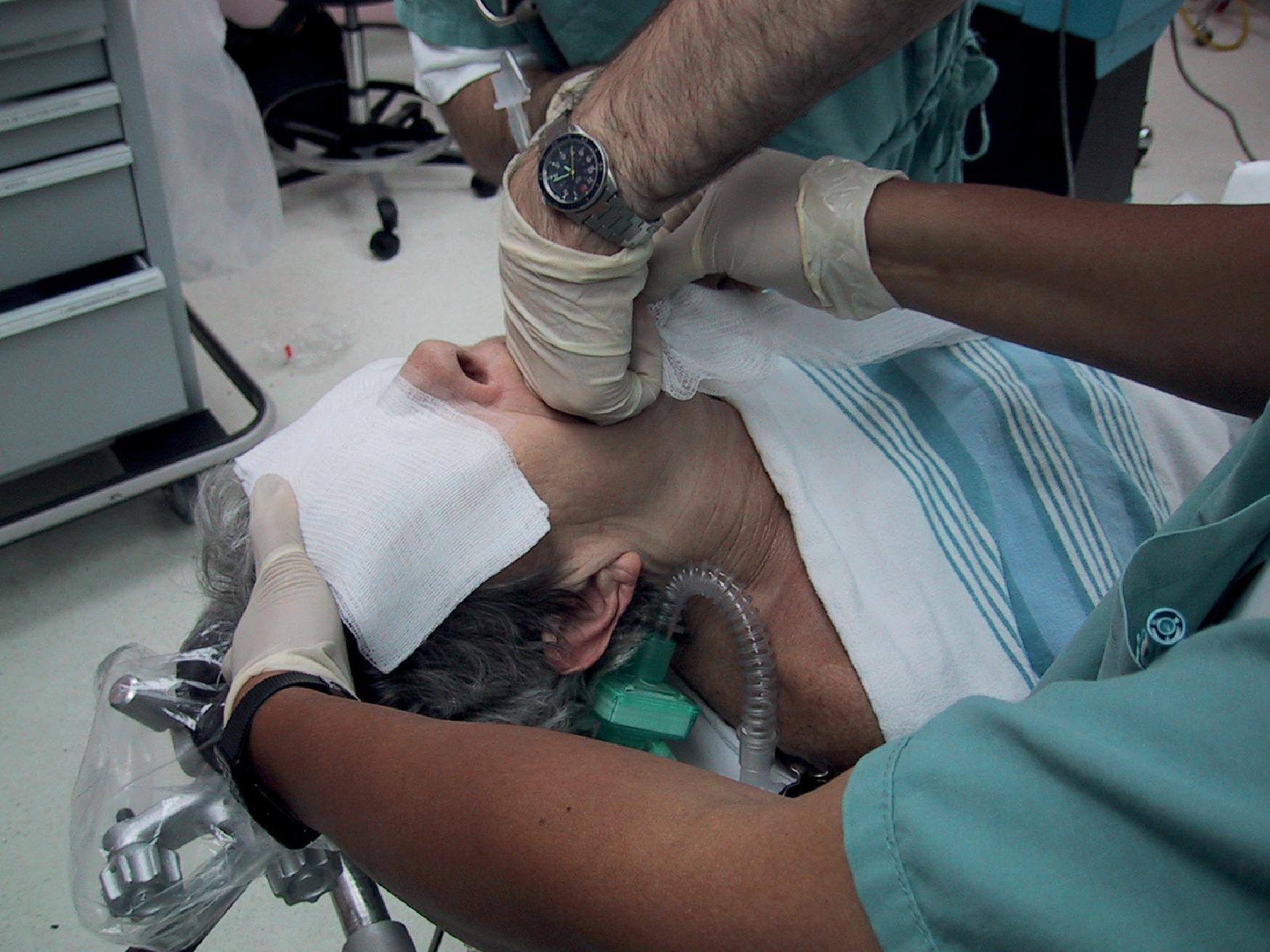
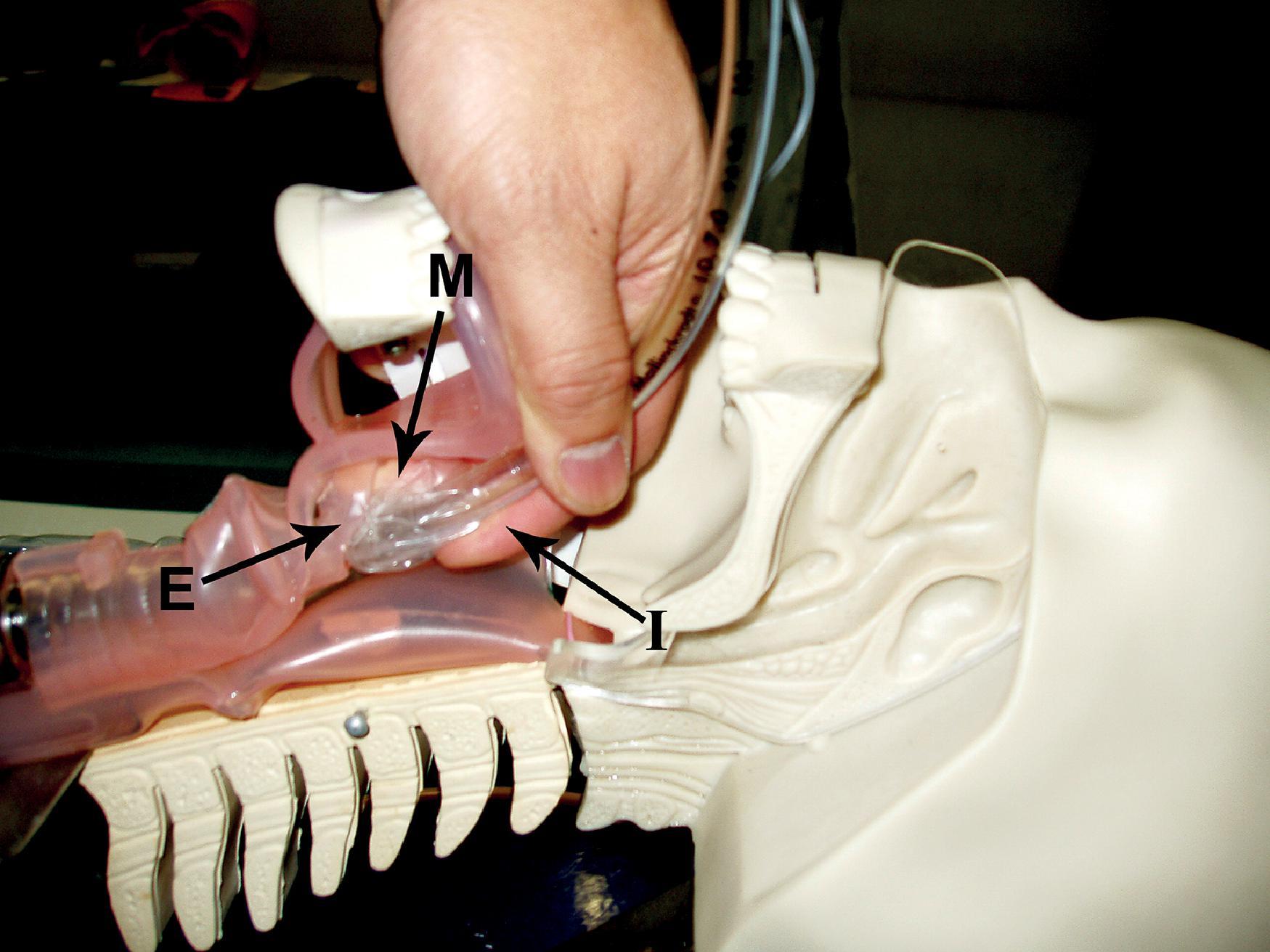
Once the epiglottis is identified and directed anteriorly, the styletted ETT is inserted through the corner of the mouth. The styletted ETT glides along the groove between the middle and index fingers on the palmar surface of the nondominant hand ( Fig. 21.8 ). While firm anterior pressure is maintained against the epiglottis with the middle finger, the styletted ETT is advanced slowly into the glottic opening by the dominant hand. The index finger may be used to guide the tip of the styletted ETT into the glottic opening ( Fig. 21.8 ). In general, the middle finger of the nondominant hand lifting the epiglottis has to be moved laterally to allow passage of the styletted ETT.
The ETT should be stabilized while withdrawing the stylet, and the ETT is then slowly advanced into the trachea. During the intubation, the styletted ETT should never be advanced forcefully against resistance. Correct tube placement is confirmed by conventional techniques, such as end-tidal CO 2 detection. Occasionally, the tip of the epiglottis cannot be palpated. An upward (cephalad) and backward (posterior) pressure applied anteriorly to the larynx by an assistant may be helpful. Alternatively, the index and middle fingers of the nondominant hand may be used to keep the styletted ETT in the midline while observing tissue movement in the anterior neck during gentle rocking of the styletted ETT back and forth to locate the glottic opening.
An alternative technique described by Cook begins with the placement of the tips of the index and middle fingers of the nondominant hand in the hypopharynx, posterior to the larynx. The ETT held in the dominant hand is then passed into the pharynx. The volar surfaces of the fingers serve as a “basketball backstop” to guide the ETT held in the dominant hand through the glottic opening. If required, the index finger of the nondominant hand may be flexed to help guide the ETT through the glottis.
Rich reported the use of a tracheal introducer (commonly known as a “bougie”) in facilitating a digital intubation technique in an unanticipated difficult airway after several failed direct laryngoscopy attempts. The tracheal introducer (e.g., SunMed ETT Introducer, SunMed, Largo, FL) was first guided into the trachea using the digital technique described above. The ETT was then guided into the trachea using the introducer as a conduit. The advantage of this technique is that it is easier to advance a tracheal introducer through the glottic opening and then pass the ETT into the trachea than it is to place a styletted ETT in the trachea. The tracheal introducer has a smaller outer diameter and is easily manipulated with the fingers to enable passage through the vocal cords. In addition, the clicks felt as the tip of the tracheal introducer brushes over the tracheal rings after flattening the angle of the introducer once it goes through the glottis, together with the “hold-up,” assist in the confirmation of tracheal placement. The ETT with the malleable stylet is more rigid and perhaps more likely to cause blunt trauma to the upper airway, especially if repeated manipulation is necessary for successful entry into the trachea.
Blind digital intubation in neonates has not gained widespread acceptance as a primary technique of intubation. Moura and da Silva performed a randomized control trial comparing neonatal direct laryngoscopic intubation to the digital method of intubation. They determined that neonatal digital intubation had a higher success rate and a shorter intubation time. A single experienced clinician was responsible for performing all the steps of the procedure, which was identified as a study limitation. It has been used in several low- and middle-income countries where experience with and access to conventional laryngoscopes are limited. Hancock and Peterson have employed the blind digital intubation technique in neonatal resuscitation and accidental extubation situations. The clinician uses the gloved index finger of the nondominant hand to identify the epiglottis and glottic opening. The index finger is then used to guide the ETT through the glottic opening. The thumb of the nondominant hand can be used to apply external cricoid pressure. A styletted ETT is recommended. The fifth finger of the nondominant hand can be used in very small neonates. Advantages of the digital technique in neonates include reduced lip and gum trauma, controlled palpation of anatomic landmarks, and easy access to the airway in various transport scenarios, without the need to adjust lines and monitor equipment in unstable patients. The technique can also be used to confirm accidental extubation of the trachea. Caution should be exercised when airway pathology is suspected. The digital intubation of neonates and infants can be considered in situations in which other visual techniques have failed, when available equipment has failed, or when inadequate access may preclude the conventional laryngoscopic technique.
The technique of digital intubation has been combined with the Beck Airway Airflow Monitor (BAAM, Great Plains Ballistics, Lubbock, TX) ( Fig. 21.9 ) and the Endotrol Endotracheal Tube (Mallinckrodt Medical, Argyle, NY) ( Figs. 21.10 and 21.11 ) to facilitate tracheal intubation in several situations where direct laryngoscopy has failed. , The BAAM was initially developed to facilitate blind nasotracheal intubation techniques under spontaneous ventilation. The BAAM produces a characteristic whistling sound during inspiration and expiration if the tip of the ETT is positioned within the air column leaving or entering the trachea. The device has also been shown to be effective in guiding nasotracheal tube placement in situations in which external cardiac massage is being applied.
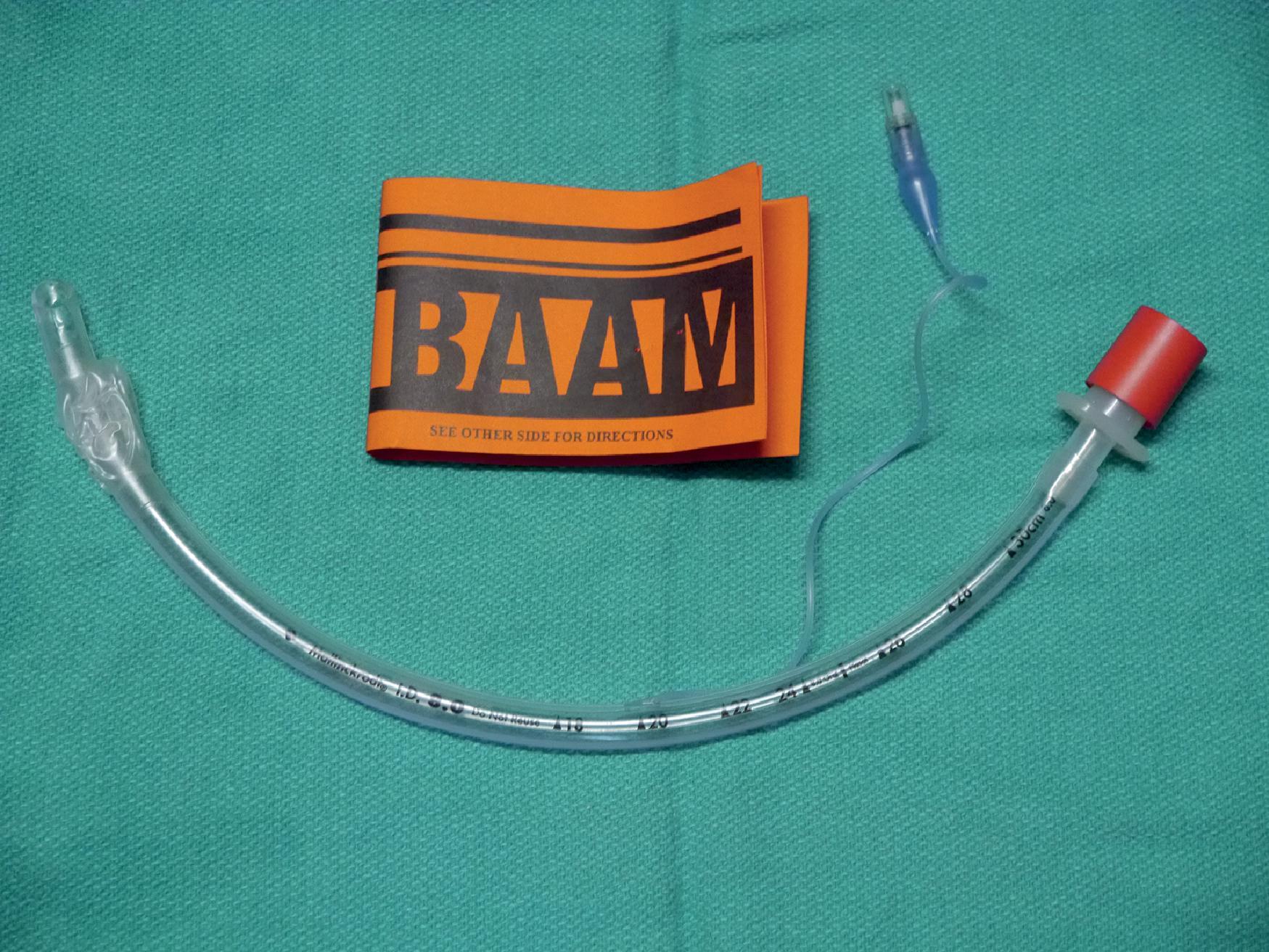
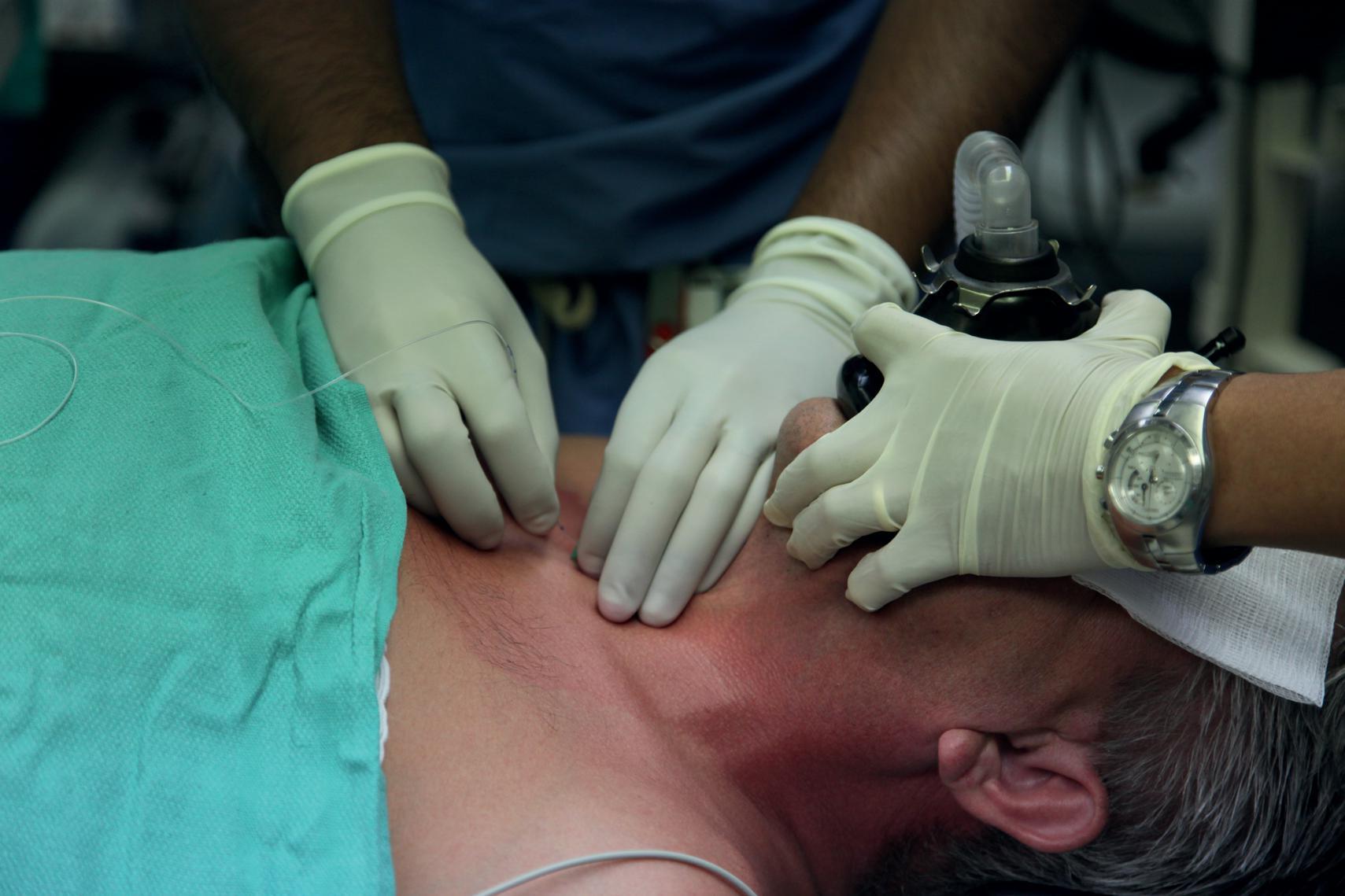
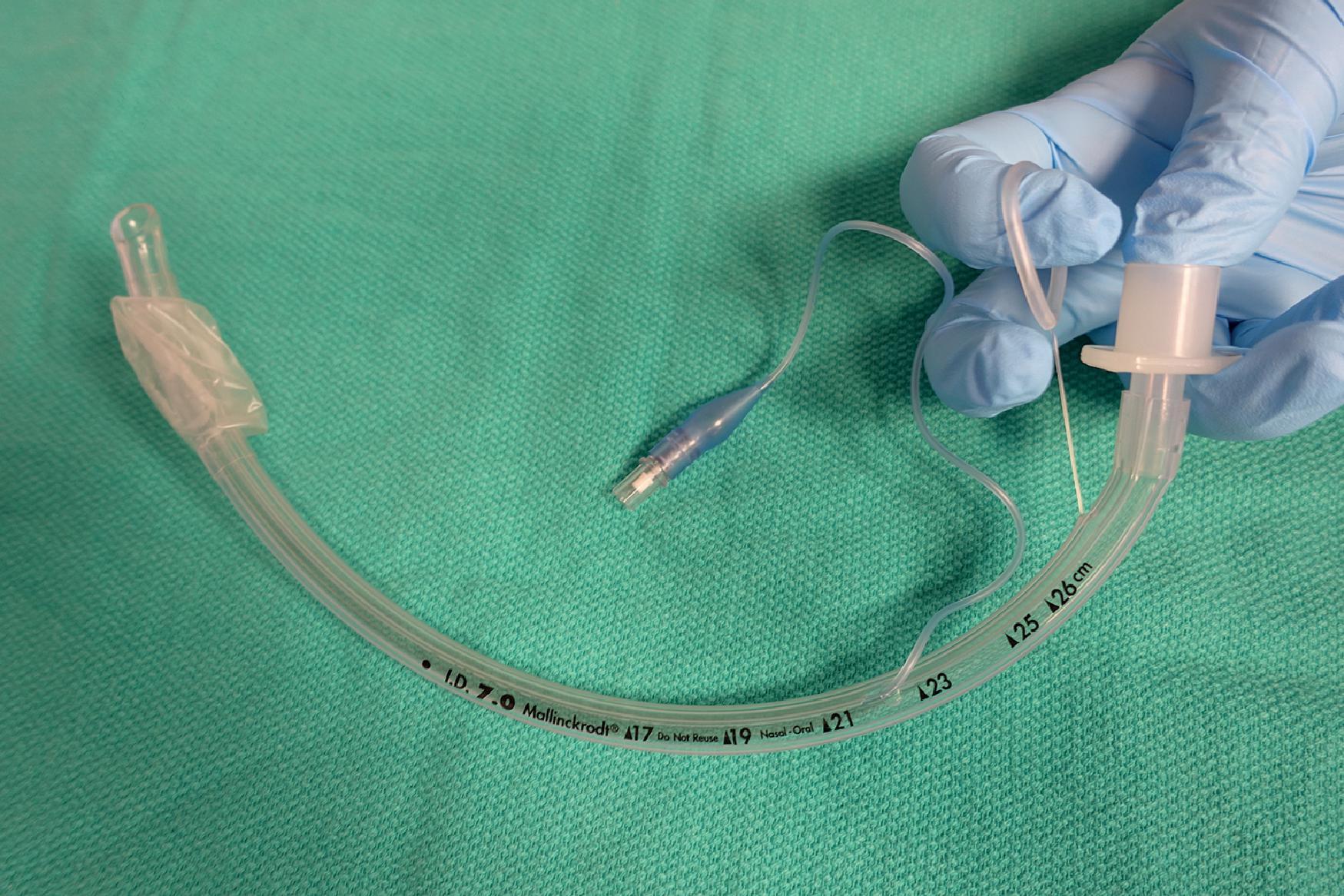
The Endotrol ETT’s ( Figs. 21.10 and 21.11 ) unique design allows the clinician to bend the distal tip anteriorly by pulling on a plastic ring attached to a wire that runs along the concave curvature of the ETT. This motion allows better alignment of the distal tip of the ETT with the glottic opening.
In tracheal intubation using an FIS it can be difficult to advance the ETT into the trachea. Asai and colleagues reported the use of the digital technique to help guide a 39-French double-lumen tube off the FIS into the trachea of a patient undergoing an anterior thoracic laminectomy procedure. Additionally, Parker Flex-Tip ETTs, which have a flexible, curved, centered, and tapered distal geometry, allow for the easier passage of the ETT off the FIS and into the glottis and can be utilized to minimize trauma to either the vocal cords or nasal turbinates.
Light-guided tracheal intubation using the Trachlight (Laerdal Medical, Wappingers Falls, NY) can be difficult in patients with a long and floppy epiglottis. This difficulty can be overcome by using the combined light-guided digital intubating technique. During the intubation, the middle finger of the nondominant hand can be used to lift the epiglottis off the posterior wall of the pharynx to allow the ETT with the Trachlight to go underneath the epiglottis into the glottic opening. The light glow from the anterior neck can be used to confirm the correct placement of the ETT tip into the glottis ( Fig. 21.12 ). Over the past two decades, one of the authors (OH) has performed >20 intubations using this combined light-guided digital intubating technique. The lighted stylet–guided digital intubation technique has been described in newborns and infants with difficult airways.
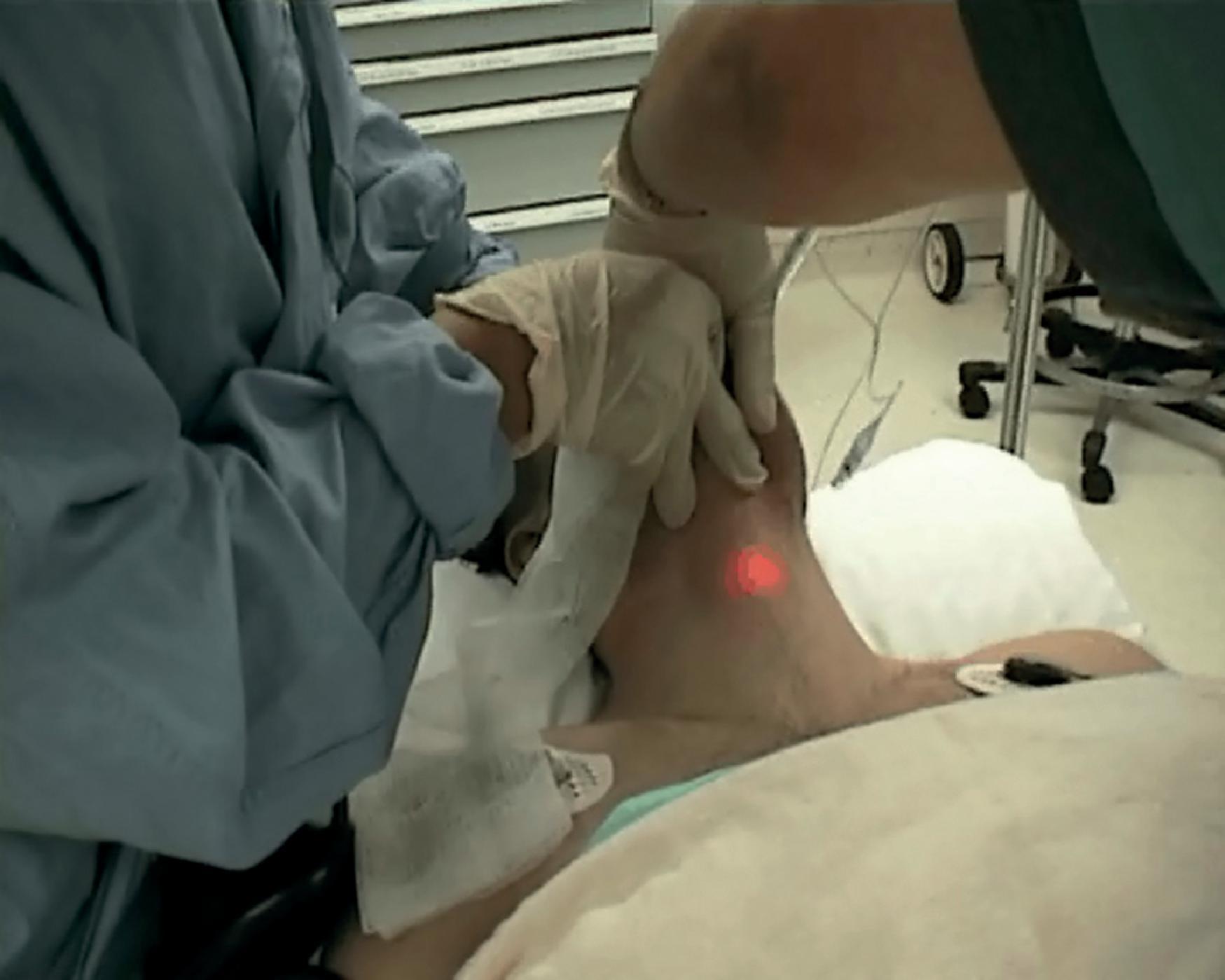
Nasotracheal intubation in the pediatric population can be combined with a digital technique to facilitate atraumatic passage of the tube behind the soft palate and entrance into the trachea. However, this has not been systematically studied in a randomized control trial.
Become a Clinical Tree membership for Full access and enjoy Unlimited articles
If you are a member. Log in here